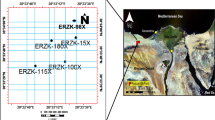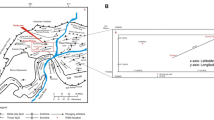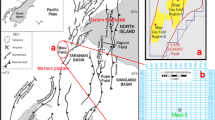Abstract
This study addresses the three-dimensional (3D) petrophysical modelling and volumetric analysis of the Farewell Reservoir in the Kupe Field in the southern Taranaki Basin, New Zealand. The qualitative petrophysical analysis of the Kupe South-1, Kupe South-3, Kupe South-4 and Kupe-6 wells helped to model the lithological and mineralogical composition of the reservoir, while the quantitative interpretation was used to identify the shale volume, porosity type and distribution, and water and hydrocarbon saturations. A 3D petrophysical model was developed on the basis of the petrophysical analysis, and it showed the spatial distribution and propagation of the petrophysical properties within the reservoir formation of the Kupe Field. Moreover, a volumetric analysis was conducted to estimate the gas reserves and probable reserve growth of the Kupe Field. The results indicated that the gross thickness of the studied reservoir formation ranges from 226.47 to 381 m, while the net reservoir thickness is between 12.95 and 140.2 m. The shale volume lies between 17.3% and 22.4%, while the total and effective porosities are between 17.9% and 27% and between 15.1% and 23%, respectively. The study also shows the presence of net pay zones with an aggregate ranging between 12.95 m and 82.45 m with variable hydrocarbon saturations. The hydrocarbon saturation is between 62.5% and 70.8%, while the water saturation is between 29.2% and 37.5%. The volumetric analysis indicates that the Kupe Gas Field contains 654.6 Bcf (18.5 × 109 m3) of gas, while the recoverable gas is estimated to be 389.87 Bcf (11.03 × 109 m3) at 50% probability. The volumetric estimation also confirms that the possible reserve growth of the Kupe Field is expected to be 60.8 Bcf (1.72 × 109 m3) of gas in the case of 50% probability estimation. The 3D models not only validate the drilled wells used in the study but also indicate future prospective zones for drilling. The results inferred from the integrated study reveal that the Farewell Formation can be characterized as a good reservoir and has potential for future drilling and further development.

(modified after Higgs et al. 2012)

(modified after Martin et al. 1994)


(modified after Qadri et al. 2017)














Similar content being viewed by others
Notes
1 ft3 = 0.028 cm3.
1 Bcf = 2.8 × 107 cm3.
1 Tcf (trillion cubic feet) = 2.8 × 1010 cm3.
References
Abd El-Gawad, E. A. (2007). The use of well logs to determine the reservoir characteristics of Miocene rocks at the Bahar North East field, Gulf of Sues. Egyptian Journal of Petroleum, 30(2), 175–188.
Asquith, G., & Krygowski, D. (2004). Basic well log analysis, 2nd Ed. AAPG Methods in Exploration 16, 13–35.
Azeem, T., Chun, W. Y., MonaLisa, Khalid, P., Qing, L. X., Ehsan, M. I., et al. (2017). An integrated petrophysical and rock physics analysis to improve reservoir characterization of Cretaceous sand intervals in Middle Indus Basin. Pakistan Journal of Engineering, 14, 212–225.
Edwards, J.D., & Sanogrossi, P.A. (1990). Summary and Conclusions, in, Edwards JD and Sanogrossi PA (Ed.) Divergent/passive Margin Basins, AAPG Memoir, 48 Tulsa, American Association of Petroleum Geologists, 239–248
El Khadragy, A. A., Eysa, E. A., Hashim, A., & El Kader, A. A. (2017). Reservoir characteristics and 3D static modelling of the Late Miocene Abu Madi Formation, onshore Nile Delta, Egypt. Journal African Earth Sciences, 132, 99–108.
El-Din, E. S., Mesbah, M. A., Kassab, M. A., Mohammed, I. F., & Cheadle, B. A. (2013). Assessment of petrophysical parameters of clastics using well logs: The Upper Miocene in El-Wastani gas field, onshore Nile Delta, Egypt. Petroleum Exploration and Development, 40(4), 488–494.
Frailey, S. M., Damico, J., & Leetaru, H. E. (2011). Reservoir characterization of the Mt. Simon Sandstone, Illinois Basin, USA. Energy Procedia, 4, 5487–5494.
Gier, S., Worden, R. H., Johns, W. D., & Kurzweil, H. (2008). Diagenesis and reservoir quality of Miocene sandstones in the Vienna Basin, Austria. Marine and Petroleum Geology, 25, 681–695.
Griffin, A.G., Bland, K.J., Field, B., Strogen, D.P., Crutchley, G., Lawrence, M.J., & Kellett, R. (2015). Reservoir Characterization of the East Coast and Pegasus basins, Eastern North Island, New Zealand. International Conference and Exhibition, Melbourne, Australia 13–16 September 2015: pp. 150–150.https://doi.org/10.1190/ice2015-2207834
Hakimi, M. H., Al-Qadasi, B. A., Al-Sharrabi, Y., Al-Sorore, O. T., & Al-Samet, N. G. (2017). Petrophysical properties of Cretaceous clastic rocks (Qishn Formation) in the Sharyoof oilfield, onshore Masila Basin, Yemen. Egyptian Journal of Petroleum, 26(2), 439–455.
Hakimi, M. H., Shalaby, M. R., & Abdullah, W. H. (2012). Diagenetic characteristics and reservoir quality of the Lower Cretaceous Biyadh sandstones at Kharir oilfield in the western central Masila Basin, Yemen. Journal of Asian Earth Sciences, 51, 109–120.
Harrison, C. W., & Dutton, S. P. (1991). Reservoir Characterization of the Frontier Tight Gas Sand, Green River Basin (p. 21879). SPE: Wyoming.
Higgs, K. E., Crouch, E. M., & Raine, J. I. (2017). An interdisciplinary approach to reservoir characterization: An example from the early to middle Eocene Kaimiro Formation, Taranaki Basin, New Zealand. Marine and Petroleum Geology, 86, 111–139.
Higgs, K. E., King, P. R., Raine, J. I., Sykes, R., Browne, G. H., Crouch, E. M., et al. (2012). Sequence stratigraphy and controls on reservoir sandstone distribution in an Eocene marginal marine–coastal plain fairway, Taranaki Basin, New Zealand. Marine and Petroleum Geology, 32, 110–137.
Islam, M. A. (2009). Diagenesis and reservoir quality of Bhuban sandstones (Neogene), Titas Gas Field, Bengal Basin, Bangladesh. Journal of Asian Earth Sciences, 35, 89–100.
Jumat, N., Shalaby, M. R., & Aminul Islam, Md. (2017). Integrated reservoir characterization of the Paleocene Farewell Formation, Taranaki Basin, New Zealand, using petrophysical and petrographical analyses. The Journal of Petroleum Exploration and Production Technology. https://doi.org/10.1007/s13202-017-0420-5.
King, P.R., Naish, T.R., & Thrasher, G.P. (1991). Structural cross sections and selected palinspastic reconstructions of the Taranaki basin, New Zealand. New Zealand Geological Survey Report. G–150.
Klett, T.R., & Gautier, D.L. (2003). Characteristics of reserve growth in oil fields of the North Sea Graben area. In 65th European Association of Geoscientists and Engineers Conference and Exhibition, 2-5 June, Stavanger, Norway, extended abstract and exhibitor’s catalogue, 4p
Knox, G. J. (1982). Taranaki Basin, structural style and tectonic setting. New Zealand Journal of Geology and Geophysics, 25(2), 125–140.
Leila, M., Kora, M. A., Ahmed, M. A., & Ghanem, A. (2016). Sedimentology and reservoir characterization of the Upper Miocene Qawasim Formation, El-Tamad Oil Field onshore Nile Delta, Egypt. Arabian Journal of Geoscience, 9, 1–13.
Martin, K. R., Baker, J. C., Hamilton, P. J., & Thrasher, G. P. (1994). Diagenesis and reservoir quality of Paleocene sandstones in the Kupe South Field, Taranaki Basin, New Zealand. AAPG Bulletin, 78(4), 624–643.
New Zealand Petroleum Reserves (2010). Report by Ministry of Business, Innovation and Employment New Zealand.(http://www.mbie.govt.nz/info-services/sectors-industries/energy/previous-reviews consultations/review-of-the-electricity-market2009/documents-image-library/New%20Zealand%20Petroleum%20-13%20kB%20PDF.pdf)
New Zealand’s Petroleum Resources Phase 1 Report Final (2009). Ministry of Business, Innovation and Employment New Zealand. (http://www.mbie.govt.nz/info-services/sectors-industries/natural-resources/oil-and-gas/petroleum-expert-reports/micheal-adams.pdf)
Qadri, S. M. T., Islam, M. A., Shalaby, M. R., & Haque, A. K. M. E. (2017). Seismic Interpretation and structural modelling of Kupe Field, Taranaki Basin, New Zealand. Arabian Journal of Geoscience, 10, 295.
Qadri, S. M. T., Shalaby, M. R., Islam, M. A., & Hoon, L. L. (2016). Source rock characterization and hydrocarbon generation modelling of the Middle to Late Eocene Mangahewa Formation in Taranaki Basin, New Zealand. Arabian Journal of Geoscience, 9, 559.
Rahman, M. J. J., & Worden, R. H. (2016). Diagenesis and its impact on the reservoir quality of Miocene sandstones (Surma Group) from the Bengal Basin, Bangladesh. Marine and Petroleum Geology, 77, 898–915.
Rider, M. (1996). The geological interpretation of well log (2nd ed.). London: Whittles Publishing. ISBN 9780954190606.
Roncaglia, L., Arnot, M., Baur, J., Fohrmann, M., King, P., Kroeger, K. F., et al. (2010). Integrated Workflow for Modelling Basin–Scale Petroleum Systems: Application to the Kupe Area. Taranaki: SPE International. https://doi.org/10.2118/133903-MS.
Satter, A., Iqbal, G., & Buchwalter, J. (2008). Practical enhanced reservoir engineering” assisted with simulation software (p. 706). Tulsa, OK: Pennwell.
Schlumberger Wireline & Testing. (1991). Schlumberger log interpretation principle/applications. Houston, TX: Schlumberger.
Schmid, S., Worden, R. H., & Fisher, Q. J. (2004). Diagenesis and reservoir quality of the Sherwood Sandstone (Triassic), Corrib Field, Slyne Basin, west of Ireland. Marine and Petroleum Geology, 21, 299–315.
Shalaby, M. R., Hakimi, M. H., & Abdullah, W. H. (2014). Diagenesis in the middle Jurassic Khatatba formation sandstones in the Shoushan Basin, northern Western Desert, Egypt. Geological Journal, 49(3), 239–255.
Uruski, C. I., Baillie, P., & Stagpoole, V. (2003). Development of the Taranaki Basin and comparisons with the Gippsland Basin: Implications for deepwater exploration. APPEA Journal, 43(1), 185–196.
Verma, M.K., & Henry, M.E. (2004). Historical and potential reserve growth in oil and gas pools in Saskatchewan; in Summary of Investigations 2004, Volume 1, Saskatchewan Geological Survey, Sak. Industry Resources, Misc. Rep. 2004-2.1, CD-ROM, Paper A-1, 20p.
Worthington, P. F. (2003). Effect of clay content upon some physical properties of sandstone reservoirs. The International Association of Sedimentologists and Special Publication, 34, 191–211.
Worthington, P. F. (2010). Net pay-what is it? what does it do? how do we quantify? How do we use it? SPE Reservoir Evaluation & Engineering, 13(5), 812–822.
Wyllie, M. R. J. (1963). The fundamentals of well log interpretations. New York: Academic Press.
Acknowledgements
Funding for this research work has been supported by a Graduate Research Scholarship (GRS–2015) from the Universiti Brunei Darussalam along with the support from the Government of Brunei Darussalam. The authors would like to thank the Ministry of Business, Innovation and Employment (MBIE), New Zealand, for generously providing the datasets. The authors are highly grateful to the Department of Physical and Geological Sciences, Universiti Brunei Darussalam, for providing workstation amenities and to Phua Eng Siong for his logistic support. The authors also express their gratitude to Schlumberger and LR Senergy for providing Petrel and Interactive Petrophysics software, respectively, for this study.
Author information
Authors and Affiliations
Corresponding author
Rights and permissions
About this article
Cite this article
Qadri, S.M.T., Islam, M.A. & Shalaby, M.R. Three-Dimensional Petrophysical Modelling and Volumetric Analysis to Model the Reservoir Potential of the Kupe Field, Taranaki Basin, New Zealand. Nat Resour Res 28, 369–392 (2019). https://doi.org/10.1007/s11053-018-9394-3
Received:
Accepted:
Published:
Issue Date:
DOI: https://doi.org/10.1007/s11053-018-9394-3




